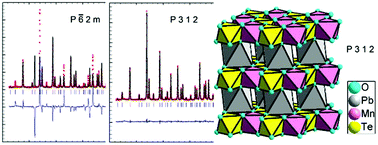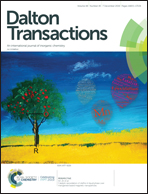PbMnTeO6: a chiral quasi 2D magnet with all cations in octahedral coordination and the space group problem of trigonal layered A2+M4+TeO6†
Abstract
Antiferromagnetic PbMnTeO6, also known as mineral kuranakhite, has been reported recently to have all three cations in trigonal prismatic coordination, which is extremely unusual for both Mn(4+) and Te(6+). In this work, the phase was reproduced with the same lattice parameters and Néel temperature TN = 20 K. However, powder neutron diffraction unambiguously determined octahedral (trigonal antiprismatic) coordination for all cations within the chiral space group P312. The same symmetry was proposed for SrMnTeO6 and PbGeTeO6, instead of the reported space groups P![[6 with combining macron]](https://www.rsc.org/images/entities/char_0036_0304.gif) 2m and P31m, respectively. PbMnTeO6 was found to be a robust antiferromagnet with an assumingly substantial scale of exchange interactions since the Néel temperature did not show any changes in external magnetic fields up to 7 T. The determined effective magnetic moment μeff = 3.78μB was in excellent agreement with the numerical estimation using the effective g-factor g = 1.95 directly measured here by electron spin resonance (ESR). Both specific heat and ESR data indicated the two-dimensional character of magnetism in the compound under study. The combination of chirality with magnetic order makes PbMnTeO6 a promising material with possible multiferroic properties.
2m and P31m, respectively. PbMnTeO6 was found to be a robust antiferromagnet with an assumingly substantial scale of exchange interactions since the Néel temperature did not show any changes in external magnetic fields up to 7 T. The determined effective magnetic moment μeff = 3.78μB was in excellent agreement with the numerical estimation using the effective g-factor g = 1.95 directly measured here by electron spin resonance (ESR). Both specific heat and ESR data indicated the two-dimensional character of magnetism in the compound under study. The combination of chirality with magnetic order makes PbMnTeO6 a promising material with possible multiferroic properties.



 Please wait while we load your content...
Please wait while we load your content...